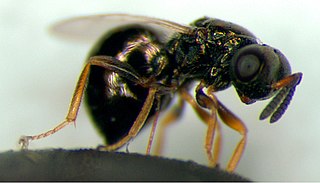
Fig wasps are wasps of the superfamily Chalcidoidea which spend their larval stage inside figs. Most are pollinators but others simply feed off the plant. The non-pollinators belong to several groups within the superfamily Chalcidoidea, while the pollinators are in the family Agaonidae. While pollinating fig wasps are gall-makers, the remaining types either make their own galls or usurp the galls of other fig wasps; reports of their being parasitoids are considered dubious.

Chalcid wasps are insects within the superfamily Chalcidoidea, part of the order Hymenoptera. The superfamily contains some 22,500 known species, and an estimated total diversity of more than 500,000 species, meaning the vast majority have yet to be discovered and described. The name "chalcid" is often confused with the name "chalcidid", though the latter refers strictly to one constituent family, the Chalcididae, rather than the superfamily as a whole; accordingly, most recent publications (e.g.,) use the name "chalcidoid" when referring to members of the superfamily.

Ficus rubiginosa, the rusty fig or Port Jackson fig, is a species of flowering plant native to eastern Australia in the genus Ficus. Beginning as a seedling that grows on other plants (hemiepiphyte) or rocks (lithophyte), F. rubiginosa matures into a tree 30 m (100 ft) high and nearly as wide with a yellow-brown buttressed trunk. The leaves are oval and glossy green and measure from 4 to 19.3 cm long and 1.25 to 13.2 cm wide.

The Braconidae are a family of parasitoid wasps. After the closely related Ichneumonidae, braconids make up the second-largest family in the order Hymenoptera, with about 17,000 recognized species and many thousands more undescribed. One analysis estimated a total between 30,000 and 50,000, and another provided a narrower estimate between 42,000 and 43,000 species.

The Pteromalidae are a large family of wasps, the majority being parasitoids of other insects. They are found throughout the world in virtually all habitats, and many are important as biological control agents. The oldest known fossil is known from the Early Cretaceous.

Eupelmidae is a family of parasitic wasps in the superfamily Chalcidoidea. The larvae of the majority are primary parasitoids, commonly on beetle larvae, though many other hosts are attacked, including spiders. Details of the life history varies considerably. They are found throughout the world in virtually all habitats.

The Ormyridae are a small family of parasitic wasps in the superfamily Chalcidoidea. They are either parasitoids or hyperparasitoids on gall-forming insects, primarily cynipid wasps and tephritid flies. The 120 or so species are cosmopolitan, except almost entirely absent from South America.
Signiphoridae is a small family of parasitic wasps in the superfamily Chalcidoidea. The roughly 80 species are placed in four genera.

Nasonia vitripennis is one of four known species under the genus Nasonia - small parasitoid wasps that afflict the larvae of parasitic carrion flies such as blowflies and flesh flies, which themselves are parasitic toward nestling birds. It is the best known and most widely studied of the parasitoid wasps, and their study forms a vital part of the information used to describe the order Hymenoptera, along with information from bees and ants. This parasitoid behaviour makes the wasps an interest for the development of biopesticide and biological systems for controlling unwanted insects.

Deinodryinus velteni is an extinct species of Deinodryinus in the wasp family Dryinidae. The species is known solely from an Eocene fossil found in the Baltic region.

Ormocerinae is a subfamily in the chalcidoid wasp family Pteromalidae.

Ceratosolen is an Old World wasp genus in the family Agaonidae. They are pollinators of the monoecious fig subsections Sycomorus and Sycocarpus, and the section Neomorphe, all belonging to the subgenus Sycomorus. The genus is native to the Palearctic, Afrotropical, Indomalayan and Australasian realms.

Apocrypta is an Old World genus of parasitic fig wasps in the family Pteromalidae. They are parasitoids of gall-wasps in the Sycophagini tribe, and especially Ceratosolen species, pollinators of the Sycomorus, Sycocarpus and Neomorphe sections of Ficus. They seem to be fig species-specific.
Robertsia is a genus of fig wasps in the family Pteromalidae, native to Papua New Guinea.

Ormyrus nitidulus is a parasitoid species of wasp in the family Ormyridae. It is primarily associated with oak gall wasps. Ormyrus nitidulus is a small metallic wasp approximately 5mm long as an adult. It has a fairly widespread distribution being found across North Africa, the Middle East, North America and Europe.

Diparidae is a family of chalcid wasps. This group was formerly treated as Diparinae, a subfamily of Pteromalidae.

Pelecinellidae is a small family of chalcidoid wasps, formerly treated as the subfamily Leptofoeninae within Pteromalidae. They, like many small chalcidoids, are brilliantly metallic.

Lyciscidae is a family of chalcid wasps. The genera comprising this family were previously placed in the Cleonyminae subfamily of a paraphyletic Pteromalidae.

Cerocephalidae is a small family of chalcid wasps, previously classified as subfamily Cerocephalinae, in the polyphyletic family Pteromalidae. Most species are parasitoids of small wood-boring beetles.

Chalcedectidae is a small family of chalcid wasps, previously classified as part of the subfamily Cleonyminae, in the polyphyletic family Pteromalidae. Most species are parasitoids of wood-boring beetles.


















